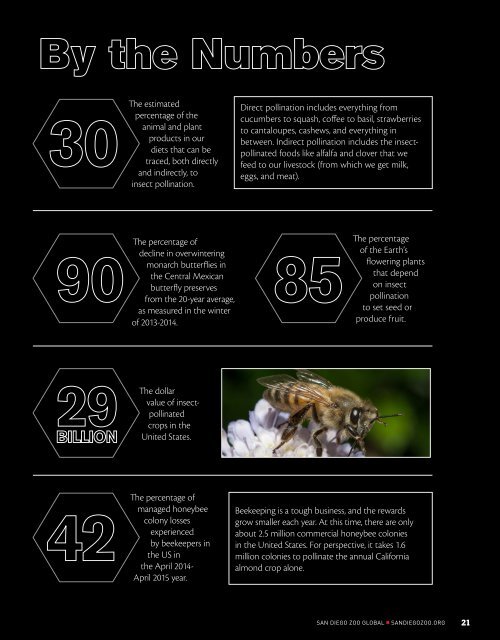You also want an ePaper? Increase the reach of your titles
YUMPU automatically turns print PDFs into web optimized ePapers that Google loves.
The estimated<br />
percentage of the<br />
animal and plant<br />
products in our<br />
diets that can be<br />
traced, both directly<br />
and indirectly, to<br />
insect pollination.<br />
Direct pollination includes everything from<br />
cucumbers to squash, coffee to basil, strawberries<br />
to cantaloupes, cashews, and everything in<br />
between. Indirect pollination includes the insectpollinated<br />
foods like alfalfa and clover that we<br />
feed to our livestock (from which we get milk,<br />
eggs, and meat).<br />
The percentage of<br />
decline in overwintering<br />
monarch butterflies in<br />
the Central Mexican<br />
butterfly preserves<br />
from the 20-year average,<br />
as measured in the winter<br />
of 2013-2014.<br />
The percentage<br />
of the Earth’s<br />
flowering plants<br />
that depend<br />
on insect<br />
pollination<br />
to set seed or<br />
produce fruit.<br />
The dollar<br />
value of insectpollinated<br />
crops in the<br />
United States.<br />
The percentage of<br />
managed honeybee<br />
colony losses<br />
experienced<br />
by beekeepers in<br />
the US in<br />
the April 2014-<br />
April <strong>2015</strong> year.<br />
Beekeeping is a tough business, and the rewards<br />
grow smaller each year. At this time, there are only<br />
about 2.5 million commercial honeybee colonies<br />
in the United States. For perspective, it takes 1.6<br />
million colonies to pollinate the annual California<br />
almond crop alone.<br />
SAN DIEGO ZOO GLOBAL n SANDIEGOZOO.ORG 21



